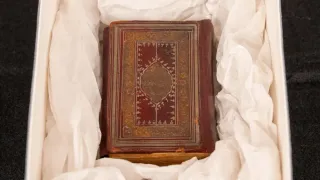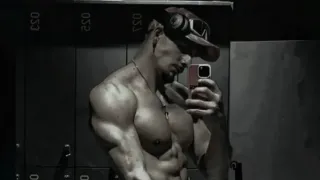March 6, 2025
Lady Gaga Strikes a Chord: The Superstar Singer Rekindles Passion for Music with New Album 'Mayhem'
Jonathan Landrum Jr. READ TIME: 5 MIN.
When Lady Gaga walked into a New York City bar she frequented five years ago, the memories hit hard: Back then, she wrote songs there, feeling lost and disconnected from herself.
But this time was different. While sitting in the bar, Gaga felt a sense of peace and rejuvenation, reminiscent of her teenage years spent scribbling lyrics on napkins.
In recent years, Gaga rediscovered her passion for music by taking a step back from the limelight, cutting ties from fake friendships, swapping the spotlight for quiet nights at home and surrounding herself with people she truly trusts. That personal transformation became the soul of her new album, "Mayhem," which is being released Friday.
"I reclaimed myself as an artist," said Gaga, a 14-time Grammy and one-time Oscar winner who returned to her dark pop music roots on the album, which spans 14 tracks. Her new project follows last year's " Harlequin," a jazz-inspired companion album for the film "Joker: Folie à Deux," which stalled at No. 20 on the Billboard 200.
But Gaga's singles for the 14-track "Mayhem" have been received well on the charts, including " Disease," " Abracadabra " and " Die With a Smile," a collaboration with Bruno Mars, spending five weeks on the Billboard Hot 100 at No. 1 and winning a Grammy for best pop duo/group performance earlier this month.
While recording "Mayhem," Gaga refused to rest on her past hits or accolades to define her new work. She credited her renewed creative drive to a journey of self-discovery, which ultimately empowered her to step back into the spotlight for several big moments last month. The superstar performed with Bruno Mars at the Grammys – including a tribute song "California Dreamin'" to Los Angeles wildfire victims, closed out the FireAid benefit concert with "All I Need is Time" and delivered a surprise performance singing "Hold My Hand" before the Super Bowl in New Orleans.
Next month, Gaga will headline Coachella and perform a free concert on Rio de Janeiro's Copacabana Beach in May.
"I built a routine in my daily life around music all the time, and not around self-promotion," said Gaga, 38, who was a producer and co-executive producer with her fiancé Michael Polansky, 41, on "Mayhem." "When my life was circulating self-promotion, I think I lost a lot of my passion. When my life was around my family, my partner and my music, it gave me back that realness."
In an AP interview, Gaga digs deeper into what it took to regain her passion, showing she's more than just a character and her pulling double duty on "Saturday Night Live" on Saturday.
Determined to prove that she's the architect of her success
While Gaga was dropping early hits like "Just Dance" and "Poker Face," she noticed critics who downplayed her role in the success, giving more credit to producers and even stylists.
With "Mayhem," Gaga aimed to showcase that her talent was the true driving force behind her rise. Fueled by the skeptics, the singer is determined to show she's the architect of her success, not just another industry creation.
"They tried to qualify and quantify me," she said. "Very often as a woman in music, they say it was other people. You're a product, like you were made. Something that was really important to me on this was really taking from myself my own inventions."
When Gaga began recording her new album, she focused on crafting the kind of dark pop melodies that defined her early career, pairing them with lyrics that spoke in code. She said it all came back naturally, giving her reassurance that she was on the right path to fully owning her identity as an artist instead of a made-up character
"This was a way for me actually to feel like I wasn't. That it was the real me," she said. "I was the creator. This was my work. It was just not a character I was playing. It was something that I made."
How Gaga pushed fame away to reclaim her creative spark
Early in her career, fame came with a price that Gaga wasn't willing to pay. She felt isolated, trapped in transactional relationships and struck in an environment that prioritized competition over creativity.
The spotlight began to feel like an endless race, draining her passion for making music. She began to notice a shift as her sales climbed beyond the first 10 million records.
Gaga realized that staying in that energy would ultimately stifle her creativity, knowing it was time to break free.
"I lost the thing that I would teach my child, which is to sit alone with your thoughts and write a poem," Gaga said. "Sit alone and write a song. Just put good old-fashioned hard work and craftsmanship into what you believe in. I lost that for a long time."
Eventually, Gaga hit reset. She cut loose draining relationships and building a stable family with Michael Polansky and their beloved dogs.
It helped Gaga channel her energy back into her artistry.
"This is the first day I've done interviews without makeup on, and it's nice," she said. "I just get to share with you about my experience with music, and I'm not feeling pressure to perform for you in any other way than as a female artist."
Gaga on SNL
In her appearance on "Saturday Night Live," Gaga will showcase her range as both the musical guest and host. But her versatility might shine even brighter in the show's sketch comedy skits.
"I get to work in all different kinds of art that I love so much," said Gaga, who will make her second appearance as "SNL" host and fifth as its musical guest. The first time she appeared as host and musical guest was in 2013.
Gaga performed during the " SNL50: The Homecoming Concert " last month.
"Doing 'SNL' is all about hard work," she said. "It's a labor of love for the audience on Saturday night because we just want everybody to feel happy at home."
To prepare, Gaga is synching up with the cast and building rapport, which she says will help balance her roles throughout the night.
"I'll just be like really close with the cast," she said. "They write like all the sketches and they work like all week long on planning, so I feel like the better my relationship is with them and just like getting in there and being one of them, the better the show will be."
Gaga added: "I'm treating my musical performances separately. I have to wear like a few different hats. There's hosting and then there's being the actor in the sketch, and being the artist that I am in my music. I'm ready to do it though."






